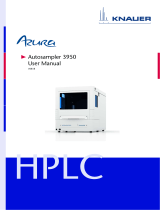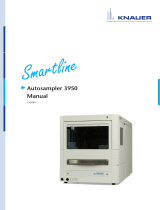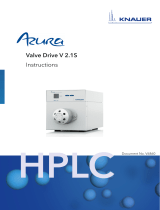Page is loading ...

1.0 DESCRIPTION
Model 8125 is a six-port micro-scale
sample injector with a built-in needle port in
the handle for sample loading. Five of the
stator ports have a dual-size port design and
accommodate both 0.5 mm (0.020") and
1/16" OD tubing. Port 3 only accommodates
1/16" OD tubing and allows the tubing to
bottom out in the port for low dispersion
connections.
2.0 SUPPLIED WITH THE VALVE
Supplied with the valve in a separate bag
are RheFlex®Stainless Steel fitting sets for
all ports and the following items. A 5 µL
sample loop comes standard with the valve.
• Hex Keys
• Wrench
• Needle Port Cleaner
• Vent Tubes
• Mounting Screws
The #22 gauge needle supplied in the valve
should be removed from the needle port
before using the valve.
3.0 SPECIFICATIONS
• Maximum Operating Pressure: 48 MPa
(483 bar, 7000 psi)
• Maximum Operating Temperature:
80°C
• Flow Passage Diameters: 0.33 mm
(0.013") and 0.3 mm (0.012")
• Wetted Surfaces: stainless steel and an
inert polymer
• Built-in position sensing switch
4.0 IMPORTANT SAFETY NOTICES
4.1 Warning: When using sample loops
larger than 100 µL, shield yourself from
mobile phase coming out of the needle port
when the valve is turned from INJECT to
LOAD. Example, 1 mL loop ejects 20 µL
upon decompression from 19 MPa (200 bar,
2898 psi).
4.2 Warning: When using the Needle Port
Cleaner, empty the syringe slowly to prevent
solvent from squirting back at you.
4.3 Caution: Rinse the valve after using
buffer solutions to prevent crystals from
forming, which can cause damage to the
rotor seal and stator face assembly.
5.0 USING PROPER NEEDLES AND
TUBING SIZES
5.1 SYRINGE NEEDLES
Use syringes with #22 gauge needles
without electrotaper and 90° (square cut)
point style. The wrong needle tip can cause
damage to the valve.
5.2 TUBING SIZES
Figure 2A shows how 0.5 mm (0.020") and
1/16" OD tubing can connect to five of the
stator ports. For low dispersion, use the 0.5
mm (0.020") OD tubing for the sample loop.
Since Port 3 is positioned differently in the
stator and the internal geometry allows 1/16"
OD tubing to bottom out in the port, no
cavity forms in the stator port (see Figure
2B). Using 1/16" OD tubing for the column
connection will not increase dispersion.
1/16" OD tubing can be used in the pump
port and the vent line ports. 1/16" OD tubing
can also be used for sample loops when
using sample volumes larger than 50 µL.
There is a negligible effect on overall
dispersion for these sample sizes.
6.0 INSTALLATION
a) To mount the valve on a panel, remove
the handle by loosening the two handle set
screws. Use the two set screws supplied to
fasten the valve to a panel.
b) Replace the handle by tightening the two
set screws on the two flats of the shaft.
c) Connect the two vent tubes supplied to
Ports 5 and 6. The outlet ends of both vent
tubes should be at the same horizontal level
as that of the needle port to avoid siphoning.
d) Connect the pump to Port 2 and the
column to Port 3. Leave the column
disconnected from the valve during initial
flushing.
7.0 OPERATION
7.1 FLUSHING THE INJECTOR
In the INJECT position, flush the needle port
with about 1 mL of mobile phase using the
Needle Port Cleaner as shown in Figure 3.
At this time, the pump flushes the loop. See
Warning 4.2.
Operating Instructions
Model 8125
Manual Micro-Scale Sample Injector
Fig. 1. Flow diagram of Models 8125 and 8126.
Fig. 2B. Port 3 design.
IDEX Health & Science • 600 Park Court, Rohnert Park, CA 94928, USA • (707) 588-2000 • Fax (707) 588-2020 www.idex-hs.com
Page 1 of 4
2320667E
08/24/2016
Fig. 2A. Dual-size port design of five of the
stator ports.

7.2 MANUAL LOOP LOADING
7.2.1 COMPLETE LOOP FILLING
In complete-filling, the volume of sample
injected is set by the volume of the loop (this
includes the valve passages). This method
produces the highest precision.
Overfill the loop with at least two to five
loop volumes of sample. Six to ten loop
volumes will provide even better precision.
An excess of sample is needed because
mobile phase near the wall of the loop is
displaced slowly due to the laminar flow
effect shown in Figure 4.
To completely fill the loop:
a) See Warning 4.1 and turn to LOAD.
b) Insert the syringe into the needle port.
You will feel tightness during the last 2-3
mm of travel as the needle passes through the
needle seal and then stops against the stator
face.
c) Load the sample.
d) Leave the syringe in and turn to INJECT.
7.2.2 PARTIAL LOOP FILLING
If you only have a small quantity of sample,
this is the method of choice. In the partial-
filling method the volume of sample injected
is set by the syringe. In this method, no more
than half a loop volume of sample should be
loaded into the loop. For example, load no
more than 10 µL into a 20 µL loop. With
larger than half the loop volume, some of the
sample is lost out Vent Line 6. This is
because sample flows down the center of the
loop at twice the average velocity due to the
laminar flow effect shown in Figure 4.
To partially load the loop:
a) In INJECT, use the Needle Port Cleaner
to flush out the needle port with about 1 mL
of mobile phase. This will flush out
contamination from the earlier injection.
This liquid will exit out Vent Line 5.
b) Follow steps a-d in Section 7.2.1.
7.2.3 LOADING BY SUCTION
a) In LOAD, dip the tube attached to Port 6
into the sample.
b) Connect an empty syringe to the Needle
Adapter assembly and suck up sample into
the loop.
c) Leave the syringe in position and turn to
INJECT.
The syringe can be used many times before
it needs to be emptied.
To load the loop with all of the available
sample, the loop should be at least four times
the volume of sample loaded. The loop is
first filled with mobile phase via the dip
tube, then the whole sample is drawn into the
dip tube and loop, followed by more mobile
phase. The sample is now sandwiched
between two zones of mobile phase in the
loop.
8.0 ADJUSTING FOR LEAKAGE OR
HIGHER PRESSURE OPERATION
There is a single pressure adjusting screw at
the handle end of the valve body. The handle
assembly is designed to be used as a tool for
adjusting this screw. If you need operation
up to a higher pressure or if there is a leak
between the stator and stator ring, loosen the
two set screws so that the handle slips down
the shaft and the two protrusions fit into the
slots on the adjusting screw. Tighten the
adjusting screw about 1/20th turn. If there is
still leakage at this new setting, repeat the
process. Replace the rotor seal if the leak
continues.
Note: When the valve is not panel
mounted, the adjusting screw can be hard to
turn. In this case, loosen the three stator
screws 1/4 turn prior to adjusting the screw.
Retighten the stator screws before testing for
leaks.
Replace the handle and tighten the two set
screws on the two flats of the shaft. Confirm
that the handle protrusions are out of the
slots in the adjusting screw before tightening
the set screws. This step is important. If the
handle engages the pressure adjusting screw
the shaft will not rotate between LOAD and
INJECT. See Figure 5.
Note: If the vent lines from Ports 5 and 6 do
not have their outlet ends at the same
horizontal level as the needle port, siphoning
can result, which is often misinterpreted as a
leak. A siphoning leak will stop when the
vent lines and needle port tube are empty. A
leak due to a damaged rotor seal will
continue.
9.0 MAINTENANCE
The only parts that may need eventual
replacement are the rotor seal, isolation seal,
and stator face assembly.
The main causes of early failure are:
a) The wrong needle tip can damage the
stator face, which then causes deep
scratching of the rotor seal surface.
b) Abrasive particles in the sample can
scratch the rotor seal surface.
Genuine IDEX Health & Science parts are
easily replaced by the following
instructions. See Section 11.0.
9.1 DISASSEMBLY
To disassemble, refer to Figure 6 and
proceed as follows:
a) Remove the handle assembly.
b) Remove the three stator screws.
c) Remove the stator, stator face assembly,
and stator ring from the body (the stator face
assembly usually remains on the stator).
d) Pull the rotor seal off the pins.
e) Pull the isolation seal off the shaft
assembly.
9.2 REASSEMBLY
To reassemble, refer to Figures 5, 6, and 7
and proceed as follows:
a) Slip the new isolation seal (open side
facing the handle) onto the stator end of the
shaft assembly next to the bearing ring.
b) Line up the new rotor seal as shown in
Figure 7. The rotor seal grooves face the
stator.
c) Replace the stator ring (with black gap
ring in place) so that the rotor pin falls
between the two milled flat surfaces of the
stator ring and the body locating pin enters
the mating hole in the body.
d) Place the pins in the new stator face
assembly into the mating holes in the stator.
e) Replace the stator and stator face
assembly on the valve so that the pin in the
stator ring enters the mating hole in the
stator.
f) Add the three stator screws. Tighten each
screw a 1/2 turn past fingertight.
g) Replace the handle and tighten the two
set screws on the two flats of the shaft.
Confirm that the handle protrusions are out
of the slots in the body before tightening the
set screws. This step is important. If the
handle engages the pressure adjusting screw
the shaft will not rotate between LOAD and
INJECT. See Figure 5.
Syringe Barrel
Needle Port Cleaner
Handle Assembly
Needle Guide
Fig. 3. Use of Needle Port Cleaner.
Fig. 4. Laminar flow effect.
Flow
Sample
Tube Wall
Mobile Phase
IDEX Health & Science • 600 Park Court, Rohnert Park, CA 94928, USA • (707) 588-2000 • Fax (707) 588-2020 www.idex-hs.com
Page 2 of 4
2320667E
08/24/2016

9.3 POSITION SENSING SWITCH
The position sensing switch is standard in
Model 8125. The switch is a magnetic reed
switch actuated by a magnet sealed inside the
shaft. The switch is rated for 100 V at 200
mA.
To replace or remove the switch:
a) Remove the handle assembly.
b) Remove the three stator screws.
c) Remove the stator, stator ring, and stop
ring.
d) Pull the switch out of the stop ring.
e) Replace with new switch, or leave the
hole empty if the switch is not needed.
f) Follow the steps in Section 9.2 to
reassemble.
10.0 OPERATING SUGGESTIONS AND
TROUBLESHOOTING
10.1 LEAKAGE
If you see liquid between the stator and
stator ring, or from the needle port or a vent
tube, tighten the pressure adjusting screw as
explained in Section 8.0. If this fails to stop
the leak then replace the rotor seal and/or
stator face assembly.
10.2 NEEDLE SEAL LEAKAGE
Since the outside diameter of syringe
needles can vary, the needle seal (Teflon1
sleeve in the rotor seal) may not seal
correctly around a needle that is smaller than
average. This will result in the loss of
accuracy in loading the sample. To make a
good seal, remove the needle from the needle
port and push in on the plastic needle guide
with the eraser end of a pencil. Repeat if
necessary.
10.3 USE OF AQUEOUS BUFFERS OR
SALT SOLUTIONS
To prevent the formation of salt crystals in
the valve which can scratch the rotor seal,
flush out the flow passages and the needle
port with water after using salt solutions.
10.4 USE OF HIGH pH SOLUTIONS
The standard rotor seal in Model 8125 is
Vespel1, a polyimide with good wear
resistance. Vespel is sensitive to alkaline
attack when exposed to solutions having a
pH of 10 or more. Use a PEEK or Tefzel1
rotor seal for alkaline solutions.
10.5 ACCURACY OF SAMPLE LOOPS
Sample loop sizes are not actual values.
Actual volumes can differ by ± 10% for a 20
µL loop. Smaller loops show greater
differences. For actual injection volume, use
the partial-filling manual sample loading
method.
11.0 RECOMMENDED SPARE PARTS
IDEX Health & Science offers a
RheBuild® K it for maintaining the quality
performance of your valve. The kit includes
all the necessary parts (rotor seal, stator
face assembly, isolation seal, needle guide,
and needle port cleaner), tools, and
instructions.
8125-999 RheBuild Kit for 8125
Body
Handle Set
Screws (2)
Pressure
Adjusting
Screw
Side
Fig. 5. Valve handle acting as wrench to adjust
valve pressure adjusting screw.
Fig. 6. Exploded view of Model 8125.
Fig. 7. Correct position of rotor seal (grooves
face the stator).
Handle Assembly
Handle Set Screws
Needle Guide
Pressure Adjusting Screw
Body
Thrust Bearing
Spring Washers
Needle Port Tube Assembly
Bearing Ring
Isolation Seal
Rotor Seal
Body Locating Pin
Gap Ring
Position Sensing Switch
Stator Ring
Stator Locating Pin
Stator Face Assemby
Stator
Stator Screws (3)
* Shaft Assembly
* Shaft Assembly includes Rotor, Shaft, and Pins.
IDEX Health & Science • 600 Park Court, Rohnert Park, CA 94928, USA • (707) 588-2000 • Fax (707) 588-2020 www.idex-hs.com
Page 3 of 4
2320667E
08/24/2016
1Vespel, Tefzel, and Teflon are trademarks of E.I. DuPont.

IDEX Health & Science • 600 Park Court, Rohnert Park, CA 94928, USA • (707) 588-2000 • Fax (707) 588-2020 www.idex-hs.com
Page 4 of 4
2320667E
08/24/2016
/





